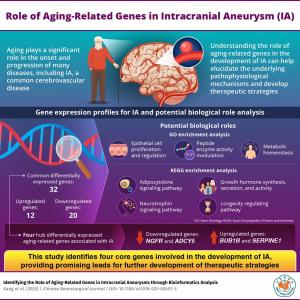Chinese Neurosurgical Journal Study Explores the Role of Aging‑Related Genes in Intracranial Aneurysms
Bioinformatics analysis-based study explores the signaling pathways & molecular mechanisms of aging-related genes in the development of intracranial aneurysms
BEIJING, BEIJING, CHINA, November 10, 2025 /EINPresswire.com/ -- Aging plays a significant role in the disease onset and progression of multiple cerebrovascular events. Identification of the core aging-related genes involved in intracranial aneurysm (IA) can help to further explore the pathogenesis of the disease. In a recent study published in the Chinese Neurosurgical Journal, researchers identified four aging-related genes through bioinformatics analysis that were closely associated with IA. Understanding their functions provided a deeper insight into the pathophysiology of IA.Intracranial aneurysm (IA) refers to a bulging or ballooning of a blood vessel in the brain. The abnormal bulge in the intracranial vascular wall is often characterized by changes in local vascular wall structure and tissue remodeling. This is one of the most common and dangerous cerebrovascular diseases. Rupture of the aneurysm often leads to stroke, coma, or death. Elderly patients have a higher risk of developing IA and the risk of aneurysm rupture also increases with age.
Aging is often associated with changes in cellular and tissue levels. Aging-associated changes are often noted in the genetic and molecular levels. Gene upregulation is the process of increasing the expression of a gene, leading to more protein production and amplified cellular function. Conversely, gene downregulation is the process of decreasing gene expression, which results in less protein and reduced cellular activity. The upregulation and downregulation of certain aging-related genes are often noted and are linked with functional changes and complications. Previous studies have reported the involvement of these genes in various cardiovascular complications.
The role of aging-related genes in the development of IA is yet to be elucidated. A team of researchers, under the guidance of Dr. Gang Yang from The First Hospital of Lanzhou University, China, performed bioinformatics analysis to understand the role of aging-related genes and the biological mechanisms associated with the development of IA. “Though there are multiple studies on the effect of aging in the onset of various diseases, its role in the development of IA remains unexplored. Understanding the involvement of aging-related genes can help to explore the pathogenesis of the disease,” mentions Dr. Yang, while talking about the main motivation behind the study. The study was published online in Volume 11 of the Chinese Neurosurgical Journal on October 07, 2025.
The team utilized two different public databases to obtain the details of the genes involved in aging and IA. Differential gene expression analysis, a statistical method used to identify genes with significantly different expression levels was performed in these two groups. To understand the functions of these genes, Gene Ontology (GO) functional enrichment analysis and Kyoto Encyclopedia of Genes and Genomes (KEGG) pathway enrichment analysis were performed. Weighted gene co-expression network analysis (WGCNA), a bioinformatics tool, was used to identify aging-related genes that have similar expression patterns in IA.
The researchers identified 32 common differentially expressed genes, among which 20 genes were upregulated and 12 genes were downregulated. GO enrichment analysis showed that these genes were mainly involved in epithelial cell proliferation and regulation, peptide enzyme activity modulation, and metabolic homeostasis. KEGG enrichment analysis data revealed that these genes were primarily involved in the adipocytokine signaling pathway. Some of these genes were involved in growth hormone synthesis, secretion and action, and some showed involvement in the neurotrophin signalling pathway.
The study also identified genes linked with the longevity regulating pathway. WGCNA analysis identified four aging-related genes related to IA. Among them, NGFR gene and ADCY5 gene were downregulated, while BUB1B gene and SERPINE1 were upregulated.
“Each of these genes are involved in different cellular pathways. Their association with IA provides interesting insights into the molecular mechanisms. Crucially, NGFR and SERPINE1 possess the potential to serve as biomarkers for IA,” mentions Dr. Yang. Future studies on these genes can aid in the development of therapeutic strategies.
Further research and understanding of the involvement of aging-related genes in the pathophysiological mechanisms of IA can help in drug discovery or biological therapies, which can minimize surgical interventions.
***
Reference
Title of original paper: Identifying the role of aging-related genes in intracranial aneurysms through bioinformatics analysis
Journal: Chinese Neurosurgical Journal
DOI: 10.1186/s41016-025-00407-5
Gang Yang
Chinese Neurosurgical Journal
467555534@qq.com
Legal Disclaimer:
EIN Presswire provides this news content "as is" without warranty of any kind. We do not accept any responsibility or liability for the accuracy, content, images, videos, licenses, completeness, legality, or reliability of the information contained in this article. If you have any complaints or copyright issues related to this article, kindly contact the author above.


